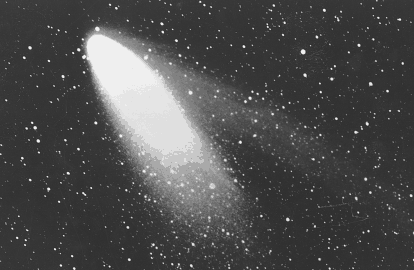Comet Hale-Bopp

 THE GREAT COMET OF 1997. Above, the bright head of comet Hale-Bopp, called the coma, is pointed towards the Sun. The coma is composed of dust and gas, masking the solid nucleus of the comet made up of rock, dust and ice. Photo taken by Jim Young at NASA's Jet Propulsion Laboratories Table Mountain Observatory in March 1997. |
An unprecedented year-long study was made of Hale-Bopp by two NASA observatories—the Hubble Space Telescope and the International Ultraviolet Explorer. Astronomers estimated that it had a monstrous nucleus about 19 to 25 mi in diameter. The average comet is thought to have a nucleus of about three miles in diameter, or even smaller. By comparison, the comet or asteroid that struck Earth 65 million years ago, possibly causing the extinction of the dinosaurs, was probably six to nine miles across.
Scientists were surprised to find that the different ices in its complex nucleus seemed to be isolated from each other. They reported seeing unexpectedly brief and intense bursts of activity from the nucleus during the monitoring period, suggesting that the nucleus must be an incredibly dynamic place. Astronomers using spectroscopic instruments were also amazed to discover that the comet had a thin, third tail composed of sodium atoms, a type never seen before.







